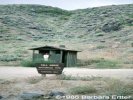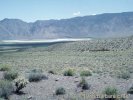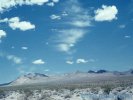 Carl Purpus, Plant
Collector in Western America
Carl Purpus, Plant
Collector in Western America 
Barbara Ertter
University and Jepson
Herbaria
University of California
Berkeley, CA 94720






Topics in this Article: Literature Cited | REPRINTED FROM
… The Plant Biology of Eastern University of California
| Literature Cited: Other Articles: A Cactus Tour (1898): 0060
At the end of April 1898, Purpus and his companion, a man named Fred Noller,
left Springville with a wagon on his last expedition through the southern Sierra
Nevada and Owens Valley [Purpus, 1898]. His goal was to cross southern Nevada
and Utah to the La Sal Mountains, but because of poor roads and drought
conditions they turned around at St. George, Utah. They followed their route
of the previous year, crossing Greenhorn and Walker passes to the Argus Range,
where they stayed at the camp of Georg Vornberg, "a friend of mine from Baden
[Germany] who owns several gold mines in the area", at the foot of Argus Peak
[Purpus, 1899].
|
| A letter written from
the Argus Range (9 May, 1898) is one of Purpus's more
entertaining ones, including references to the drought conditions, the
difficulties in pressing plants in the desert, and his contacts:
|
| Letters: 5/9/1898 | It is a great pity to see the cattle starve to dead [sic] on the desert, but it is a frolic for me to see the sheep die there will be about half of them left next fall which is a good thing.
| Locations: Salt Wells. Letters: 5/9/1898
| I try the best to press the plants as nice as possible, although it is very hard sometimes on the road. Coming through the desert I had spread some plants out to dry near Salt Wells, covered with rocks. There came a whirlwind and away went one bundle sky high. I got the plants and paper again but not in good shape. I was raging made[sic] about it.
| Letters: 5/9/1898 | At Indian wells I made the acquaintance of Mr. Austin superintendent of the schools in Inyo Co. at Independence. He asked me to see him and his wife, who he says was a[n] enthusiastic botanist. He told me Mrs. Austin had received a beautiful Astragalus from a schoolboy with scarlet flowers he did not know the name. I told him it was very likely Astrag. coccin. Brandegee. Mr. and Mrs. Austin will be very valuable acquaintances.
| Other Articles: Nevada and Utah Desert (1898): 0040 Locations: Darwin. Junction Flat. Keeler.
Purpus explored the eastern part of the Argus Range before crossing Junction
Flat and skirting the northern portion, which Purpus called the Madurango Range.
He then crossed the desert to Darwin, over the northern edge of the Coso
Mountains, and along the edge of Owens Lake to Keeler:
|
|  Owens Lake, looking north, from south of Keeler.
Owens Lake, looking north, from south of Keeler.
Locations: Owens Lake. | Our route traversed sparsely vegetated volcanic mountains, dark brown or burnt red, with a variety of extinct craters. We made camp facing broken volcanic rockpiles on top of the pass. The next morning we travelled through an exceptionally sandy region to Owens Lake, where we camped for a day next to a warm sulfur spring. The following day our journey continued to Keeler, situated in the center of a dry lake bed. To the east of Keeler rose the deeply carved ridges and craters of the Inyo Mountains, with Pinus monophylla on its highest peaks. To the west, the snow-covered teeth of the Sierra Nevada ascended, blanketed in clouds.
|  "Tollhouse" sign, White Mountains, California.
"Tollhouse" sign, White Mountains, California.
Other Articles: Nevada and Utah Desert (1898): 0050 Locations: Big Pine. Independence. Lone Pine. Toll House. Westgard Pass.
Purpus and his companion arrived at Lone Pine, above which Mt. Whitney "rose
like a gigantic tooth amidst a row of lesser peaks of similar shape, dropping
vertically into a small valley" [Purpus, 1898]. From here they continued up
Owens Valley to Independence and on to Big Pine, where he noted an abundance of
Prunus andersonii, as well as Forestiera neomexicana. They then turned east
towards Westgard Pass, collecting for two days at the "Tollhouse". "We were
presented with a magnificent view of the freshly snow-covered high peaks of the
Sierra Nevada, shoved together like the side wings of a theater stage."
|
|  Deep Springs from Westgard Pass, White Mountains, California.
Deep Springs from Westgard Pass, White Mountains, California.
Locations: Deep Springs Valley. They
crossed the pass and descended into Deep Spring Valley, arriving May
19, "a magnificent day". He describes his journey:
|
| Other Articles: Nevada and Utah Desert (1898): 0080
| The route was at first rugged, then relatively flat through stands of Pinus monophylla, and then over a high plain beyond which we descended gradually into the valley. Deep Spring Valley is a meadow-filled valley enclosed by mountains, with a small lake located at its lower end. The lake is fed by strong springs on its southern banks. Here I rested a day and found at the lake's outlet the beautiful Philadelphus microphyllus, which until now had not been found in California.
|  Gold Mountain area from north end of Death Valley, California.
Gold Mountain area from north end of Death Valley, California.
Other Articles: Nevada and Utah Desert (1898): 0090 Locations: Fish Lake Valley. White Mountains. Gold Mountain. Palmetto Range. Red Mountains. Letters: 5/28/1898
Purpus also explored the mountains south of the valley before crossing over
to Fish Lake Valley: "The southern end is for the most part desert, but the
northern is well watered and covered with grassy flats. The Palmetto Range and
Red Mountains are to the east, and to the west are the White Mountains". That
night it rained in the valley and snowed in the mountains, giving the landscape
a wintery appearance. The next day they crossed the border into Nevada. Here
they spent over a week in the Palmetto Range and Gold Mountain, waiting for the
neck of one of their mules to heal. Fortunately the collecting was good (28 May,
1898): "I must say the whole mountain range is a perfect paradise for botanists
at the right time and I guess I got here just in time, although for the high
mountain flora it is much to[o] early." In his next letter (2 June, 1898) he
describes some of the added features that made the area one of his more
productive stops:
|
| Locations: Oriental. Letters: 6/2/1898
| We camp at the Stateline mine, which is shut down for many years and I have rooms to dry my plants, to separate them etc as large, as Your herbarium and this is a very great accomodation because outside I could do nothing the wind is blowing sometimes so strong, that it takes our plates away. . . . In the building where I dry my plants I have about 8 tables. I hardly think, that I will find an other place like this. Mr. Stewart who is watching the property of the Compagny[sic] is a very nice man and he takes a pleasure to help me in my work he is also a very valuable acquaintance for the future. . . . He also knows places where is thousands of Calochort[us] aureus or C. Kennedyi v[ar]. aur[eus]. On account of the very dry season it has not come up this year, so he will have them collect for us next year by squaws. He sent out a squaw after it but she could not find a single stem. . . .
| Letters: 6/2/1898 | It is a big difference between these mountains and that Big sheep Pasture called Sierra Nevada, here are no sheep at all, because they can not come them in and that is the reason I make such a fine collection.
| Other Articles: Nevada and Utah Desert (1898): 0620 Locations: Bridgeport. Porterville. Sonora Pass. Mount Magruder. Sand Spring. Saint George.
After his journey to St. George, Purpus returned to the Palmetto area in
August to collect seeds and late-season plants, during which time he climbed Mt.
Magruder. He then proceeded north through Fish Lake Valley and camped at Sand
Spring, "a lovely clear spring . . . located in the sandy waste on the
north[east]ern base of the White Mountains". From here he made one last
expedition into the adjacent White Mountains before continuing north, across the
Excelsior Range, through Bridgeport, and over Sonora Pass, returning to
Porterville in October.
| |
[Previous Page] [Next Page] | |
| [Published Biographies] [Travelogues and Articles] [Letters] [Plant Lists and Bibliography] [Site Administration] | | Date and time this article was prepared: 6/7/2002 7:32:35 PM |